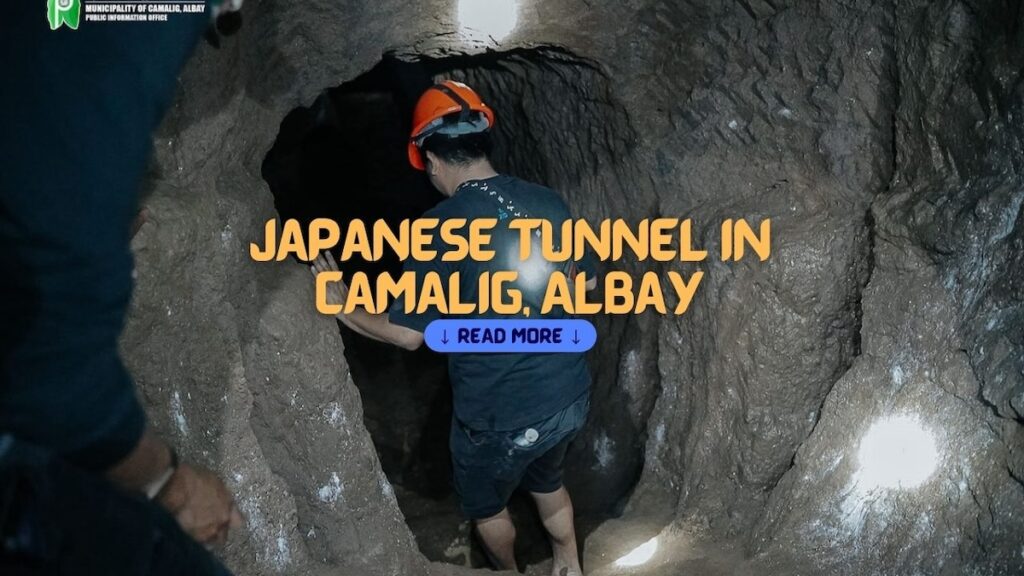WW II Japanese Tunnel in Camalig, Albay
8 min read
Visit the Japanese Tunnel in Camalig – A Piece of WWII History
During World War II, the Philippines was occupied by Japan, and many structures were built to support the war effort. One such structure is the Japanese Tunnel located in Camalig, Albay. The tunnel was built by the Japanese Imperial Army in the 1940s and served as a fortress for the occupying forces.
Recently, the Japanese Tunnel has been opened to the public as a historical tourism site. The tunnel is considered a significant part of the country’s history and is expected to boost local tourism and cultural heritage. Extensive restorations were conducted to ensure the safety of tourists and visitors.
Visitors to the Japanese Tunnel can take a guided tour of the site and learn about its history. The tunnel is notable for its strategic importance and for being the location where American forces overcame Japanese resistance, signaling a turning point in Albay and in the entire Bicol Region during the war. The opening of the Japanese Tunnel is an exciting development for Camalig town, promising additional livelihood opportunities for residents.
Historical Context
Japanese Occupation of the Philippines
During World War II, the Japanese Imperial Army occupied the Philippines from 1942 to 1945. The occupation was marked by widespread human rights abuses, including forced labor, rape, and murder. The Japanese soldiers were ruthless in their treatment of the Filipino people, and the country suffered greatly under their rule.
Role of Camalig’s Tunnels in World War II
Camalig, a town in Albay province, played a significant role in the war effort against the Japanese. The town was strategically located and was a key point of resistance against the Japanese forces. The Japanese Imperial Army recognized the importance of Camalig and established a number of tunnels in the area to serve as fortresses and headquarters.
One of the most notable tunnels is the Japanese Tunnel at Quituinan Hill in Barangay Tinago. The tunnel, which is 35 meters long and two meters wide, was used as a fortress by the Japanese Imperial Army during their occupation in the 1940s. It was a site of significant strategic importance and was the location where American forces overcame Japanese resistance, signaling a turning point in Albay and in the entire Bicol Region during the war.
Today, the Japanese Tunnel in Camalig serves as a historical tourism site and an important reminder of the town’s role in the war effort. The tunnel has undergone extensive restoration work and is now open to visitors who want to learn more about the town’s history and the sacrifices made by the Filipino people during World War II.

Exploring the Tunnels
The Japanese Tunnel in Camalig, Albay is a historical site that is expected to attract many visitors. The tunnel was built during World War II to serve as an arsenal facility for Japanese soldiers.
Mapping the Tunnel
The Japanese Tunnel is a network of underground passageways that spans over 200 meters. The tunnels are narrow and can be quite dark, so visitors are advised to bring a flashlight.
To ensure the safety of visitors, the tunnel has been mapped out and marked with signage. There are also tour guiding services available to lead visitors through the tunnels and provide information about the history of the site.
Renovating the Entrance
The entrance to the Japanese Tunnel has been renovated to make it more accessible to visitors. The entrance is now wider and more spacious, making it easier for visitors to enter and exit the tunnel.
In addition, the entrance has been fitted with safety features such as railings and steps to ensure that visitors can safely navigate the entrance area.
Cleaning the Pathways and Surroundings
The pathways and surroundings of the Japanese Tunnel have been cleaned and maintained to provide visitors with a safe and enjoyable experience. The pathways are well-lit and free of debris, making it easy for visitors to explore the tunnels.
The surroundings of the Japanese Tunnel have also been landscaped to provide visitors with a scenic view of the surrounding area. From the top of the hill, visitors can enjoy a panoramic view of the Mayon Volcano and the surrounding countryside.

Cultural and Economic Development
The opening of the World War II Japanese tunnel in Camalig, Albay, has positively impacted cultural and economic development in the area. Camaligueños proudly showcase their cultural heritage to tourists, while the local government is keen on promoting the site as a new tourist attraction.
Agricultural Growth
The restoration of the Japanese tunnel has also brought agricultural growth to the area. The local government has encouraged farmers to plant crops that tourists demand, such as chili, cacao, and coffee. This has led to increased agricultural production and income for the farmers.
Preserving and Promoting Cultural Heritage
Preserving and promoting cultural heritage is essential for the growth of the tourism industry. The opening of the World War II Japanese tunnel in Camalig, Albay, has allowed the locals to showcase their cultural heritage to tourists. The local government has also taken steps to promote the site as a new tourist attraction. It has invested in restoring the tunnel to ensure the safety of tourists and visitors.
The restoration of the Japanese tunnel has also created job opportunities for the locals. The local government has hired locals as tour guides, maintenance workers, and other related fields. This has helped in reducing the unemployment rate in the area.
Tourism Management and Conservation
Safety Measures for Tourists
The local government of Camalig, Albay, has implemented safety measures to protect tourists visiting the World War II Japanese tunnel. Tourists are required to register at the entrance and pay a small environmental fee. Tourists are also advised to wear proper clothing and footwear and to avoid bringing flammable materials inside the tunnel. In addition, tour guiding services are available to assist and guide tourists.
Regulations and Restrictions
To preserve the historical significance of the tunnel, the local government has implemented regulations and restrictions. Acts of vandalism are strictly prohibited, and those caught will be penalized. Tourists are also advised to refrain from touching or moving any artifacts or items inside the tunnel. Furthermore, the number of tourists allowed inside the tunnel at any given time is limited to ensure the safety of both tourists and the tunnel itself.
Environmental Conservation Efforts
The local government of Camalig, Albay, is committed to preserving the environment surrounding the Japanese tunnel. In addition to the environmental fees tourists pay, the government has implemented a waste management system to properly dispose of any waste generated by tourists. The government also encourages tourists to practice responsible tourism by avoiding littering and respecting the natural environment.
Visitor Information
Entrance Fees
The Camalig Tourism Office provides basic services to accommodate visitors, such as guided tours and information about the tunnel’s history. The maximum fee for a tour is PHP100 per 5 people, with group rates available for parties of five people or less. Visitors are required to pay a P20 entrance fee per person to access the site.
The capacity for tunnel tours is limited, so it is recommended that visitors book in advance to secure a spot. The tourism office can also provide information about nearby accommodations for those wishing to stay overnight.

Preservation Efforts
Restoration and Maintenance
The Japanese tunnel in Camalig, Albay, has undergone extensive restorations to preserve its historical significance. The 35-meter-long, two-meter-wide tunnel was once a fortress for the Japanese Imperial Army during the Philippines’ 1940s occupation. The restoration efforts aimed to preserve the tunnel’s original structure and ensure visitors’ safety. In cooperation with concerned organizations, the local government has provided the necessary funds and manpower to restore and maintain the tunnel.
Regular maintenance is also being conducted to ensure visitors’ safety and the tunnel’s preservation. The local government has provided regular cleaning and repair services to keep the tunnel in good condition. The tunnel’s walls have been reinforced, and the surrounding area has been landscaped to provide visitors a safe and comfortable environment.
Educational Significance
Preserving and promoting the educational significance of the Japanese tunnel is a top priority for the local government. The tunnel serves as a living reminder of the atrocities committed during World War II and the resilience of the Filipino people. The tunnel’s historical significance is promoted through educational tours and other activities highlighting its importance in Philippine history.
The local government has also provided basic services to visitors, such as restrooms and parking areas. These services are essential in providing a comfortable and convenient experience for visitors, which in turn helps in promoting the tunnel’s educational significance.
Capacity is being closely monitored to ensure that the tunnel’s preservation efforts are not compromised. The local government has implemented measures to control the number of visitors to the tunnel to prevent overcrowding and minimize the risk of damage to the tunnel’s structure.
Vandalism is a significant threat to the preservation efforts of the Japanese tunnel. The local government has implemented strict measures to prevent vandalism, such as installing security cameras and deploying security personnel to monitor the area.

Frequently Asked Questions
What historical events led to the Japanese tunnel construction in Camalig, Albay?
The Japanese tunnel in Camalig, Albay, was constructed during World War II when the Japanese Imperial Army occupied the Philippines. It was built as a fortress for the Japanese army and was strategically located at Quituinan Hill in Barangay Tinago. The site played a significant role in the war, as it was where American forces overcame Japanese resistance, signaling a turning point in Albay and the entire Bicol Region during the war.
How long was the Japanese-built tunnel in Camalig, and what was its strategic importance during WW II?
The Japanese tunnel in Camalig, Albay, is approximately 40 meters long and 7 feet high. It was strategically important during World War II because it was a fortress for the Japanese Imperial Army. The tunnel was used to store ammunition, weapons, and other supplies and was also used as a hiding place for Japanese soldiers during American bombing raids.
What artifacts or remnants from the World War II era can be found inside the Camalig tunnel?
Visitors to the Japanese tunnel in Camalig, Albay, can see several artifacts and remnants from the World War II era. These include Japanese writing on the walls, old ammunition boxes, and other items left behind by the Japanese soldiers who occupied the tunnel during the war.
Are guided tours available for visitors to the Japanese tunnel in Camalig, Albay?
Yes, guided tours are available for visitors to the Japanese tunnel in Camalig, Albay. The tours are conducted by knowledgeable guides who provide visitors with historical information about the tunnel and its significance during World War II.
What are the operating hours for tourists interested in visiting the Japanese tunnel?
The Japanese tunnel in Camalig, Albay, is open to visitors daily from 8:00 AM to 5:00 PM.
Has the Japanese tunnel in Camalig been preserved or renovated since its original construction in WW II?
The Japanese tunnel in Camalig, Albay, has been preserved and maintained since its original construction during World War II. The site has been developed as a historical tourism site, and efforts have been made to ensure that the tunnel remains in good condition for visitors to enjoy.
Follow the Out of Town Travel Blog on Facebook, Twitter, Instagram, and Pinterest if you want more travel and food-related updates.
Read:





